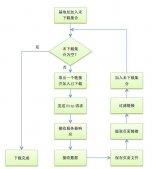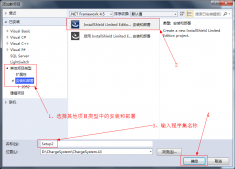因为Linq的查询功能很强大,所以从数据库中拿到的数据为了处理方便,我都会转换成实体集合List<T>。
开始用的是硬编码的方式,好理解,但通用性极低,下面是控件台中的代码:
|
1
2
3
4
5
6
7
8
9
10
11
12
13
14
15
16
17
18
19
20
21
22
23
24
25
26
27
28
29
30
31
32
33
34
35
36
37
38
39
40
41
42
43
44
|
using System;using System.Collections.Generic;using System.Data;using System.Linq;using System.Text;using System.Threading.Tasks;namespace Demo1{ class Program { static void Main(string[] args) { DataTable dt = Query(); List<Usr> usrs = new List<Usr>(dt.Rows.Count); //硬编码,效率比较高,但灵活性不够,如果实体改变了,都需要修改代码 foreach (DataRow dr in dt.Rows) { Usr usr = new Usr { ID = dr.Field<Int32?>("ID"), Name = dr.Field<String>("Name") }; usrs.Add(usr); } usrs.Clear(); } /// <summary> /// 查询数据 /// </summary> /// <returns></returns> private static DataTable Query() { DataTable dt = new DataTable(); dt.Columns.Add("ID", typeof(Int32)); dt.Columns.Add("Name", typeof(String)); for (int i = 0; i < 1000000; i++) { dt.Rows.Add(new Object[] { i, Guid.NewGuid().ToString() }); } return dt; } } class Usr { public Int32? ID { get; set; } public String Name { get; set; } }} |
后来用反射来做这,对实体的属性用反射去赋值,这样就可以对所有的实体通用,且增加属性后不用修改代码。
程序如下:
|
1
2
3
4
5
6
7
8
9
10
11
12
13
14
15
16
17
18
19
20
21
22
23
24
25
|
static class EntityConvert { /// <summary> /// DataTable转为List<T> /// </summary> /// <typeparam name="T"></typeparam> /// <param name="dt"></param> /// <returns></returns> public static List<T> ToList<T>(this DataTable dt) where T : class, new() { List<T> colletion = new List<T>(); PropertyInfo[] pInfos = typeof(T).GetProperties(); foreach (DataRow dr in dt.Rows) { T t = new T(); foreach (PropertyInfo pInfo in pInfos) { if (!pInfo.CanWrite) continue; pInfo.SetValue(t, dr[pInfo.Name]); } colletion.Add(t); } return colletion; } } |
增加一个扩展方法,程序更加通用。但效率不怎么样,100万行数据【只有两列】,转换需要2秒
后来想到用委托去做 委托原型如下
|
1
|
Func<DataRow, Usr> func = dr => new Usr { ID = dr.Field<Int32?>("ID"), Name = dr.Field<String>("Name") }; |
代码如下:
|
1
2
3
4
5
6
7
8
9
10
11
12
13
14
15
16
|
static void Main(string[] args) { DataTable dt = Query(); Func<DataRow, Usr> func = dr => new Usr { ID = dr.Field<Int32?>("ID"), Name = dr.Field<String>("Name") }; List<Usr> usrs = new List<Usr>(dt.Rows.Count); Stopwatch sw = Stopwatch.StartNew(); foreach (DataRow dr in dt.Rows) { Usr usr = func(dr); usrs.Add(usr); } sw.Stop(); Console.WriteLine(sw.ElapsedMilliseconds); usrs.Clear(); Console.ReadKey(); } |
速度确实快了很多,我电脑测试了一下,需要 0.4秒。但问题又来了,这个只能用于Usr这个类,得想办法把这个类抽象成泛型T,既有委托的高效,又有泛型的通用。
问题就在动态地产生上面的委托了,经过一下午的折腾终于折腾出来了动态产生委托的方法。主要用到了动态Lambda表达式
|
1
2
3
4
5
6
7
8
9
10
11
12
13
14
15
16
17
18
19
20
21
22
23
24
25
26
27
28
29
30
31
32
33
34
35
36
37
38
39
40
41
42
43
44
|
public static class EntityConverter { /// <summary> /// DataTable生成实体 /// </summary> /// <typeparam name="T"></typeparam> /// <param name="dataTable"></param> /// <returns></returns> public static List<T> ToList<T>(this DataTable dataTable) where T : class, new() { if (dataTable == null || dataTable.Rows.Count <= 0) throw new ArgumentNullException("dataTable", "当前对象为null无法生成表达式树"); Func<DataRow, T> func = dataTable.Rows[0].ToExpression<T>(); List<T> collection = new List<T>(dataTable.Rows.Count); foreach (DataRow dr in dataTable.Rows) { collection.Add(func(dr)); } return collection; } /// <summary> /// 生成表达式 /// </summary> /// <typeparam name="T"></typeparam> /// <param name="dataRow"></param> /// <returns></returns> public static Func<DataRow, T> ToExpression<T>(this DataRow dataRow) where T : class, new() { if (dataRow == null) throw new ArgumentNullException("dataRow", "当前对象为null 无法转换成实体"); ParameterExpression paramter = Expression.Parameter(typeof(DataRow), "dr"); List<MemberBinding> binds = new List<MemberBinding>(); for (int i = 0; i < dataRow.ItemArray.Length; i++) { String colName = dataRow.Table.Columns[i].ColumnName; PropertyInfo pInfo = typeof(T).GetProperty(colName); if (pInfo == null) continue; MethodInfo mInfo = typeof(DataRowExtensions).GetMethod("Field", new Type[] { typeof(DataRow), typeof(String) }).MakeGenericMethod(pInfo.PropertyType); MethodCallExpression call = Expression.Call(mInfo, paramter, Expression.Constant(colName, typeof(String))); MemberAssignment bind = Expression.Bind(pInfo, call); binds.Add(bind); } MemberInitExpression init = Expression.MemberInit(Expression.New(typeof(T)), binds.ToArray()); return Expression.Lambda<Func<DataRow, T>>(init, paramter).Compile(); } } |
经过测试,用这个方法在同样的条件下转换实体需要 0.47秒。除了第一次用反射生成Lambda表达式外,后续的转换直接用的表达式。
以上所述是小编给大家介绍的C#中DataTable 转实体实例详解,希望对大家有所帮助,如果大家有任何疑问请给我留言,小编会及时回复大家的。在此也非常感谢大家对服务器之家网站的支持!
原文链接:http://www.cnblogs.com/lclblog/p/6701814.html















